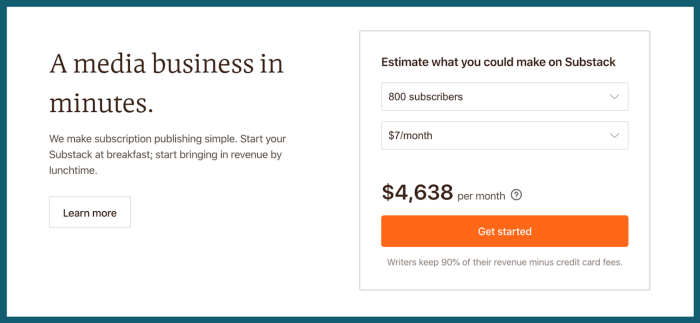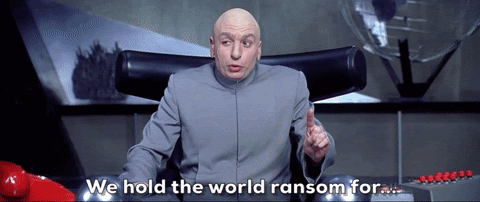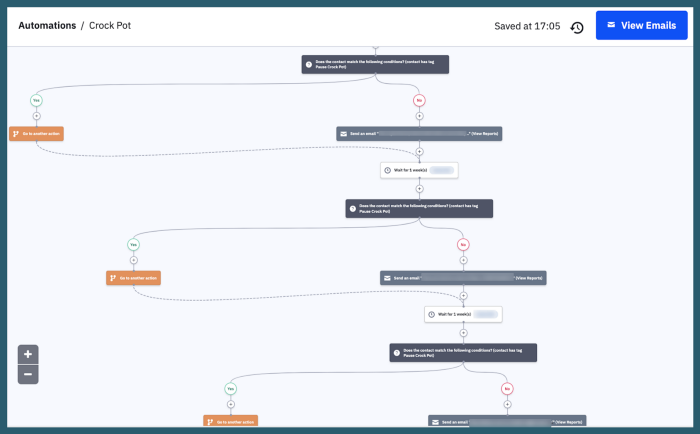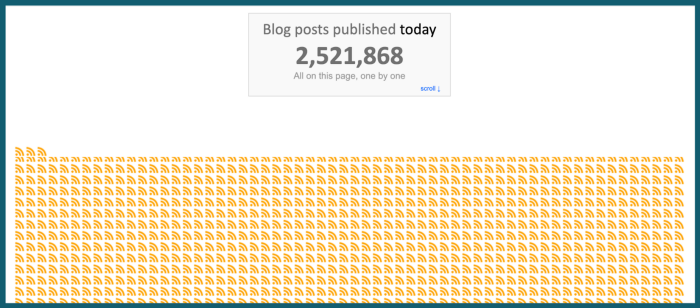Are you thinking about using Substack to create an email list and send newsletters? Here’s my advice: Don’t.
When it comes to artists and creatives sharing their work online, there have been three distinct pivot points in the last 15 years.
- Social media flipped the script — Rather than go through agencies or media outlets to get your work seen, you could simply curate your work in your own corner of the internet instead
- Influencers came and ruined everything — A scenario surfaced in which personalities — usually very loud ones — who figured out how to command attention from the masses could name their prices on product placement or co-branding opportunities
- The creator economy is a happy medium— People want to create art authentically, and now can decide for themselves how much they want to incorporate the basics of business
To be clear, the creator economy has been around for a while; the pandemic caused buzz to surge considerably in the last couple of years, both for professionals and Silicon Valley. Stay-at-home directives forced curiosity about creator life, and now there’s no going back.
In the creator economy, your dream of getting paid to create art is more tangible than ever before.
There are many ways to get paid.
And Substack has been very visible this year, so aspiring writers and creators are migrating to it.
They even have a goddamn interactive calculator on their front page to help your imagination run wild.

I’ve got my Ruth Bader Ginsburg collar on and am ready to dissent. But before I do that, let’s zoom out and first address an important question.
Why Do You Even Write?
A quick story: Earlier this year, I did a bunch of 1-on-1 research calls with readers on my email list to learn more about them and what they’re working on.
(Do these any time you need a refresh on ideas or positioning. They are gold and add some humanness to this whole internet game.)
In one particular conversation, a writer who wanted to develop his side hustle told me his goal was to get an article published in a publication on this platform.
“Tell me why you want that,” I replied.
“Well, then I’ll be published.”
“Got it. So what does that give you?”
“Well… I’ll have been published. I’ll be seen.”
“Got it. You’ll be seen — which gives you… what?”
(This continued back and forth a few more times. Eventually I asked him what being published would mean.)
“It means that I will have made it as a writer.”
My sense is that this sentiment is true for a lot of writers. They want bylines in all the sexiest publications… but they aren’t sure completely why, and in the meantime more eyeballs seems to be a step in the right direction.
This is also unfortunately why a lot of aspiring creators will fail in the creator economy. They don’t take enough time to really think about why they write or create and adjust their approach accordingly.
Step one: Figure out why you write.
Then — if you want to make money from your writing — decide on which of the 4 creator approaches below appeals most to you.
Your 4 Options As A Creator
Too many people fail because they’re trying to grow a massive audience AND sell courses AND do a paid newsletter AND write about what they want rather than what their audience wants.
It might be helpful to pick one strategy and run with it. You could spin this creator thing into a valid side hustle or job in one of four ways:
- Influencer — build the biggest, most engaged audience possible, then monetize access to this audience in the form of partnerships, brand deals, or book deals
- Creator — Build an engaged audience, then cut the middleman and invite followers to pay you directly in exchange for your best, most valuable and most entertaining stuff
- Infopreneur — Make people aware of your expertise and perspective, bring them into your orbit, and then invite them to purchase your IP (Intellectual Property) in the form of products, programs, or services. This is the category both me and my clients are in. Freelancers also go here.
- Hobbyist — Ignore the money and create because you love it. (To be clear, some of you have a “business” that makes no revenue. That’s a hobby, not a business; let’s call a spade a spade.)
All of these approaches are valid and all of them work — and that’s what makes the creator/influencer economy space so damn confusing.
Influencer mentality has infected the other approaches
There is an obsession with audience size and overall follower count. When it comes to business, audience size doesn’t matter as much as you might think.
It’s more important to reach the *right* people than it is to reach a lot of people.
Of the four options, the creator route has the broadest appeal at the moment — and also the most hype. There’s a purity to creatorship; people LOVE buying into the creator fantasy.
That, my friends, is why Substack will win — even though it sucks.
Email And Substack
In case you missed it: Substack is a newsletter platform with a monetization feature. It was founded in 2017 and positions itself as the future of the writing business.
Substack is a valid response to an important trend: Dying newsrooms.
- According to a University of North Carolina study, there were half as many newsroom jobs in 2019 as there were in 2004.
- The New York Times also estimates that 30,000 journalism jobs were lost or furloughed during the pandemic, forcing some of our best writers into entrepreneurship.
- Additionally, millennials will make up 75% of the workforce by 2025, and they tend to underestimate the challenges of entrepreneurship.
Side note: Substack is increasingly becoming “the platform for the deplatformed,” as Chris Stokel-Walker noted in this excellent piece for WIRED. What happens when violent speech gets classified as independent journalism?
What fascinates me about Substack is that everything it does can be done easily by other email service providers. Substack’s value proposition has existed for many, many years on the internet, yet everyone is exacting like it’s this Earth-shattering new approach.
Even Dua Lipa has a freaking email newsletter now. That’s because email newsletters, when used correctly, crush most other marketing strategies. Substack makes it easy to start a list.
As a service provider, however, Substack has flaws. Let’s talk about them now.
Substack’s value proposition is to start a paid newsletter
But paid newsletters are one of the most difficult online business models, y’all. Courses, consulting, programs, and coaching are more achievable for us mortals when it comes to revenue and profit.
The success stories used in Substack’s marketing are all established authors with decades of experience in their craft. That’s why quotes like this piss me off:

These statements are designed to whip up the creator fantasy. A lot of you don’t even have 100 people paying you.
A lot of you don’t have ten people paying you. Work on that first and stop comparing yourself to people who have 10,000 paid subscriptions.
I happen to know several writers on here (Who have very big followings, way more popular than you and I will ever be) who have taken a swing at a paid newsletter.
Most have failed.
Unless you’re offering amazing and exclusive content on a regular basis — or have a story that is incredibly compelling to people — paid newsletters can be a content grind.
And look — I don’t want this article to leave you feeling all doom and gloom. Online entrepreneurship is awesome and it’s having a Renaissance moment right now.
Online entrepreneurship can be your ticket to freedom and fulfilling your destiny, or it can simply be a healthy injection of beer money into your bank account every month. It’s what you want to make of it. 🍻
What I want you to think about is how the amount of energy you’d be putting into a paid newsletter could probably be spent on other approaches that are much more lucrative.
Substack doesn’t have automations
Every week I scream into the abyss about how email automations are the number one thing that will create time and leverage for you as a writer.
Let me ask you something: Why are you spending 8+ hours on an article that won’t see the light of day again after about a week? (This is important. Often, writers and creators are more interested in the act of creation itself than the outcomes of their creation.)
Business-minded people do not think this way. Business-minded people are thinking about strategy, leverage, and return on time investment constantly.
It’s not because we’re Dr. Evil; it’s because we are very tight on time and need to use time carefully.

When you write good stuff that’s aligned with your purpose and your focus, you want to keep sharing it and keep helping people.
Automations are how you can reach readers more frequently without running out of time or spiraling into burnout.
Below is a screenshot of one of my automations. When people sign up for one of my freebies and join my email list, I send a few warmup emails, then send a new newsletter every Sunday.
For new subscribers, though, they are also sent emails on Fridays for their first few months with me.
I wrote all these emails over a year ago. I still send a fresh newsletter every Sunday, but this simple automation helps me double my content marketing and reuse my best emails.

If I want to pause it at any time or skip a week, all I do is add a tag called “Pause Crock Pot” to my subscribers. It takes about 60 seconds. Can’t do any of that with Substack. Say it with me: Automations are my friends.
No personalization
The first name personalization tag is a nice touch and a way to build rapport with people on your email list. Loads of email marketing metrics show that personally addressing your reader results in better read-through rate, and putting someone’s first name in a subject line increases open rate.

“But I don’t care about open rate, I just want to create!” Look, that’s fine, but if you can’t handle learning new things or doing things you don’t feel like doing each week, entrepreneur life may not be for you.
Sometimes you have to stop chopping away at the tree, take a step back, and sharpen your axe. This takes restraint and willpower.
Most people aren’t willing to do that.
That’s why Substack will win — it appeals to tree-choppers more than axe-sharpeners.
No real SEO juice (Unless your niche is ultra-specific)
Some people tout Substack’s benefits as a self-publishing platform and as a way for people on the internet to read their work without subscribing. They declare that they’ll be discovered online with this approach.
I just want to make sure you’re clear on the state of SEO in 2021.
Don’t get me wrong, SEO traffic — people finding you from a search engine query — is amazing traffic. It’s focused, your reader already has intention, and they’re taking action.
But depending on your topic, SEO can quickly become an insurmountable brick wall.
Do you write about health, or marketing, or personal development? Godspeed to you in trying to make it onto Google’s first page in 2021.
The internet is big and competitive. Here’s a depressing site that shows you in real time how many blogs have been published on the internet today.

If you’re writing about 7 things you should do before 7am to have a great day… you’re gonna need more than a publish button for your SEO strategy to fly.
And besides, this website has way higher domain authority than Substack. Publish here instead.
The Biggest Challenge Of All, Though
Is that Substack, Patreon, OnlyFans, and other creator platforms don’t have a built-in audience.
So if you’re one of these armchair critics saying “A paid newsletter… getting paid while I lay on a beach in Bali… yup, that’s for me”, I want to make sure you’re clear on the path you want to go down and the obstacles that lie ahead.
Here is the question you MUST answer:
Where will your email subscribers come from?
Do you already have 250,000 Twitter followers? No? That means Substack is going to be tough.
That applies to all email marketing, actually.
If building an audience feels hard… that’s because it is. It requires steady, sustained effort and putting yourself out there on a regular basis.
Celebrate having 3 new email subscribers this week, even if it feels small.
In another week, you’ll have 8 or 12 signups. Maybe one week you have 20 or 40. It goes up from there as you get better.
Audience Growth Is A Two-Pronged Strategy
- The first prong is finding a way to reach new fans.
- The second prong is finding a way to nurture your existing fans.
In some cases, one platform covers both of these prongs. Usually, though, you’ll need to tackle them separately.
I like using a social platform (Like this one) for the first prong and an email list for the second prong.
For about 70% of aspiring creators, the moment they hear this news… they give up. They’d rather be in their fantasy and not do the unsexy stuff.
So they create and create and create and create, with mixed results, until burnout arrives and turns something they once loved into something they despise.
Don’t let that happen.
Recap And What To Do Next
Before you go down the Substack rabbit hole or any other email rabbit hole, let’s review the details you should iron out beforehand to set yourself up for success.
- Clarify why you write. Is it to freelance? Is it to build an audience? Is it to feel creatively fulfilled? If you press pause and take some time to define what you really want (And why you want that), this whole internet entrepreneurship thing gets less overwhelming. Sharpen the axe now, not later.
- Learn the ropes of an email service provider. Tools like Mailchimp and ConvertKit can be intimidating at first, but once you have the hang of ’em you’ll be hooked. Many are free for your first 1,000 or 2,000 subscribers. (You could even do your own paid newsletter offer from these if you want using PayPal, I explained that here)
- Treat creation like a muscle. Approach your craft the way a basketball player practices free throws or the way a bodybuilder shapes their arms. When you build up strength and fluency, the creation process gets faster and easier, and your audience growth will begin to snowball.
Take a moment to reassess your goals. Substack might be a good fit for you… but it might also be another shiny object stopping you from truly realizing your dreams. Get clear on what you really want, then go after it with gusto and you’ll be well on your way.
Thanks For Reading 🙏🏼
Keep up the momentum with one or more of these next steps:
📣 Share this post with your network or a friend. Sharing helps spread the word, and posts are formatted to be both easy to read and easy to curate – you'll look savvy and informed.
📲 Hang out with me on another platform. I'm active on Medium, Instagram, and LinkedIn – if you're on any of those, say hello.
📬 Sign up for my free email list. This is where my best, most exclusive and most valuable content gets published. Use any of the signup boxes on the site.
🏕 Up your writing game: Camp Wordsmith is a free online resources portal all about writing and media. Get instant access to resources and templates guaranteed to make your marketing hustle faster, better, easier, and more fun. Sign up for free here.
📊 Hire me for consulting. I provide 1-on-1 consultations through my company, Hefty Media Group. We're a certified diversity supplier with the National Gay & Lesbian Chamber of Commerce. Learn more here.


